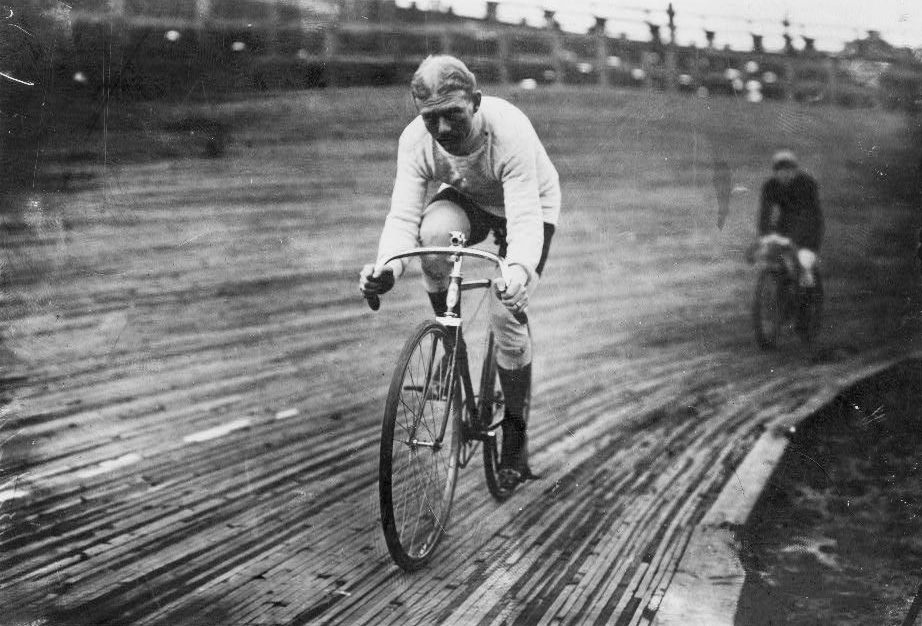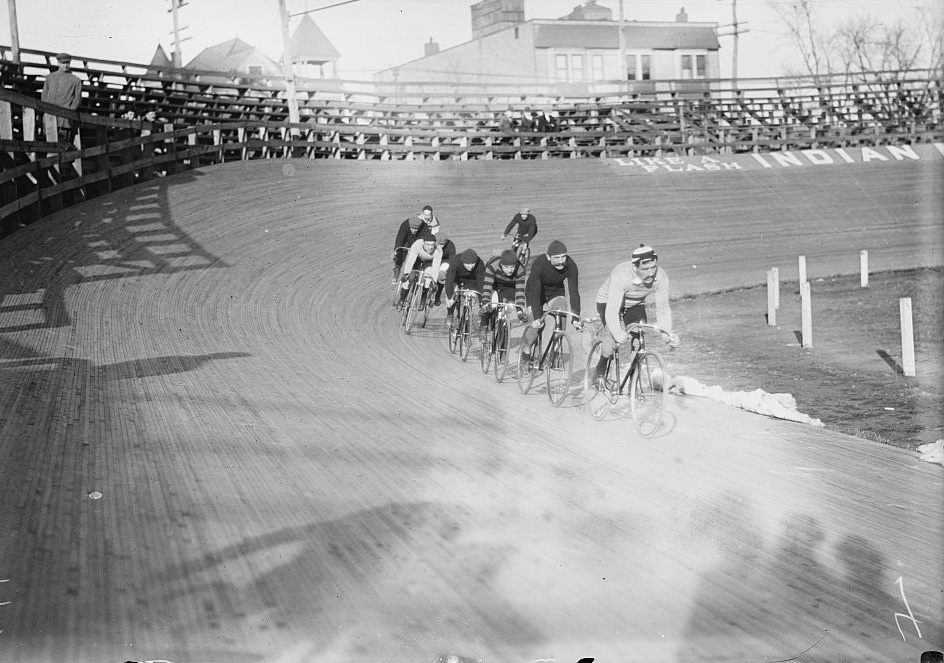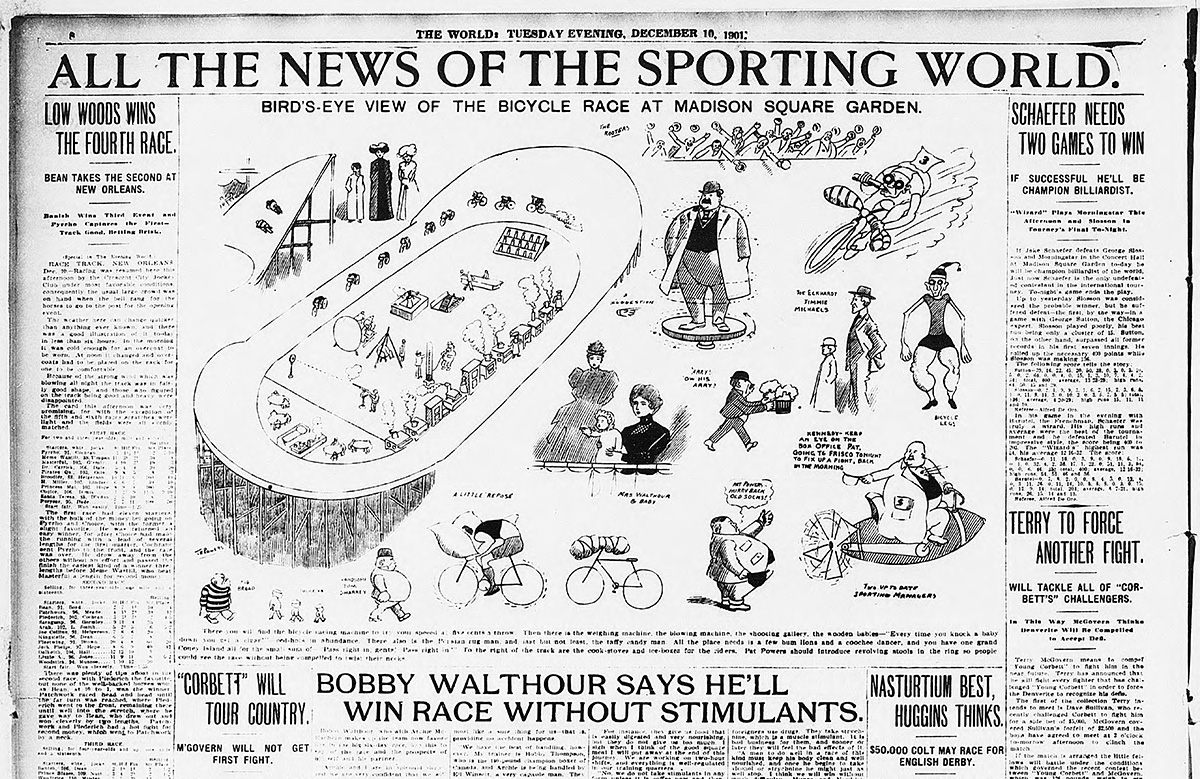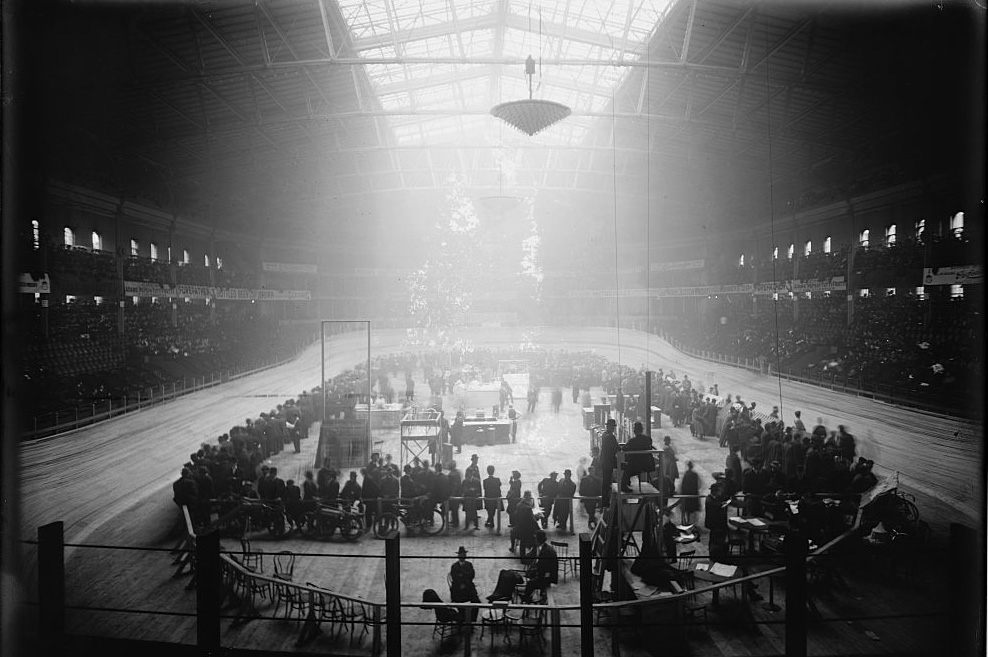America’s Short, Violent Love Affair With Indoor Track Cycling
A fun Friday night once meant going to the velodrome to watch cyclists collide.
Imagine a dystopian scenario. You fall into a coma and wake up 50 years from today. Among many disconcerting changes (podcasts now download directly to your brain, “Florida” is the name of a sea), the America of 2066 is missing one very unexpected thing: a sport that in 2016 filled stadiums like Madison Square Garden, whose fans included movie stars and chart-topping musicians, whose players received obscenely high salaries, has vanished completely from the national consciousness. Basketball is no more.
Think that couldn’t happen? Witness the shocking demise of a once equally beloved American winter sport: indoor bicycle racing.
Back in the day, indoor cycling was just as popular as basketball is today—and harder on athletes’ bodies than Sunday night football. Cycling races got their start in the 1890s as endurance events in which cyclists pedaled for six days straight without food or sleep—a feat that made for good theater but often made cyclists go “queer in the head,” according to the New York Times. After New York and Chicago passed laws prohibiting this exhausting race format in 1898, cyclists started racing in pairs that switched off every few hours, maintaining the popular six-day format while giving riders some chance to rest. (This was the format that, considerably shortened, became today’s madison.)
The partnered six-day races were still plenty exciting. Gripping the bike’s front wheel was the only way for riders to brake, and dramatic crashes were an everyday event. Broken collarbones and life-threatening skull fractures were common; one Chicago track with particularly steeply banked curves was known to fans as “the suicide saucer.” Add to that a nightclub atmosphere, in which betting was rife, live bands played, and cigar smoke flowed so thick it could obscure riders’ vision, and it makes a little more sense why this would be Al Capone’s favorite sport.

Cyclist Bobby Walthour during a six-day race in 1909. (Photo: Library of Congress/LC-USZ62-105081)
At their peak popularity in the 1920s, the six-day bike races at Madison Square Garden and Chicago Stadium were front-page news at The New York Times and The Chicago Tribune, and drew tens of thousands of fans including Barbara Stanwyck and Capone (who, predictably, liked to bet on the sprints). At least one American rider, Jimmy Walthour of Park City, IL, took home a $100,000 contract, making him as well-paid as Babe Ruth. Races in smaller cities across the country, including Newark, Minneapolis, and Detroit, drew substantial crowds, too. Madison Square Garden, however, was so strongly associated with the races that there’s a cycling event to this day known as a “madison”—or in French, the race à l’americaine.
But sometime around World War II, the fun stopped.
As early as 1938, the races at Madison Square Garden were being bumped for tamer, less gangster-friendly events like ice-skating shows. But it was the World War that was the real killer, as young men who might have kept the sport of cycling going were shipped to battlefields instead. Forty-four six-day bike races were held in Chicago between 1915 and 1942, but only one occurred after the war. The Basketball Association of America, which would later become the NBA, formed in 1946, and the management knew an opportunity when it saw one. Basketball teams began booking games at big stadiums, and our modern winter-sports schedule was born.
Today, there are only about 29 velodromes in the entire United States. At the 2016 Olympics in Rio, Americans only took home two medals across 10 different track cycling events. (For comparison, Great Britain won 10.) If you ask an American about track cycling, they’re likely to answer: “You mean that weird European sport where they ride around in circles on really skinny bikes?”

Cyclists practicing for a six-day race, c. 1909. (Photo: Library of Congress/LC-DIG-ggbain-04378)
Even calling it a “European sport” might be a bit of a misnomer. It’s true that in Europe the indoor cycling tradition isn’t forgotten: several cities including Berlin, Rotterdam, and Ghent still hold well-attended six-day races every year. But today, their popularity has largely been eclipsed by that of road races like the Tour de France. When it comes to indoor cycling as spectator sport, it’s Japan that really carries the torch. An indoor cycling event called the keirin, invented in 1948 as a betting sport, is still wildly popular there; cyclists who participate in the four-day-long meets can earn hundreds of thousands of dollars a year.
It’s hard to pin down the reasons behind bike racing’s precipitous decline in popularity among Americans, but the country’s car culture seems to be a major culprit. By the early 1950s, Americans had begun tying their national self-image to big gas-powered machines, and dismissing bicycles as small, effeminate, and European. The Chicago Tribune was already hyping this reason in 1962, when it covered the destruction of the city’s main amateur velodrome in Humboldt Park. This was seen as a crushing blow for the sport, as many successful professional racers had gotten their start on this public track.

French cyclist Léon Georget, who came third in the six-day race in 1907. (Photo: Library of Congress/LC-DIG-ggbain-04379)
In the suburbs, however, there were still velodromes left. In the 1980s, a former six-day race mechanic and bike-shop owner named Oscar Wastyn, Jr. helped organize regular Thursday-night cycling races at the outdoor Ed Rudolph Velodrome in Northbrook, IL, not far from Chicago city limits. Though the riders were all amateurs, sometimes as many as a thousand spectators would turn out to watch, according to Wastyn’s son Scott.
It was Scott’s only taste of the fast-paced racing he’d heard so much about from his grandfather, Oscar Wastyn, Sr., who’d been a mechanic in the six-day races (as well as the previous owner of the family bike shop). But even then, he had a sense of missing out. “Six-day cycling was a different animal,” Scott says. “Those were professional cyclists, that was their living. These people, it wasn’t their living. They were doing it for fun.” The Northbrook Park District eventually took over the Thursday night races, which still draw as many as 200 riders each summer according to its website.
Today, Wastyn still presides over his grandfather’s (and father’s, and great-grandfather’s) bike shop in Chicago. The walls are festooned with six-day memorabilia, including two brightly painted trunks used by the racers Bill Jacoby and Erwin Pesek. Former racers often donate keepsakes like this to the store, Wastyn says, “so their grandchildren won’t sell them in a garage sale.”

Coverage of the Madison Square Garden bike race from December 10, 1901, including the headline “Bobby Walthour says he’ll win race without stimulants”. (Photo: Library of Congress)
Neither car culture, nor the destruction of amateur velodromes, nor the NBA can totally explain why America’s Jazz Age obsession with bike racing goes so unremembered today. There is no gangster movie in which Al Capone meets his associates at the cycling track. And what American would consider track cycling their preferred spectator sport?
Maybe the problem was more to do with nationalism. Beloved as it was in America, cycling was never an exclusively American sport. Cities from Buenos Aires to Sydney to Berlin hosted their own six-day races in the 1920s, and many of the stars who drew big crowds at the Garden and Chicago Stadium were French, German, or British. This made sense in the europhile 1920s, when Paris was the center of the cultural world; not as much in the 1950s, when the US was a newly minted superpower and Europe was receding into the background.
The Cold War was when America wrote many of its myths about itself, myths that last to the present day. The international sport of indoor track cycling might have been left out of the collective consciousness simply because it didn’t fit the narrative of American exceptionalism. In a decade when it had to define itself on the world stage, America needed a winter sport that had been invented by Americans, the way that American football and baseball had been. And the glamorous, dangerous international sport of indoor cycling simply didn’t fit the bill.











Follow us on Twitter to get the latest on the world's hidden wonders.
Like us on Facebook to get the latest on the world's hidden wonders.
Follow us on Twitter Like us on Facebook